#Immigration Detainees
Explore tagged Tumblr posts
Text
#ex-manus island detainees#australia#asylum seekers#port moresby#unpaid rent#papua new guinea#immigration and australia#asylum evictions
3 notes
·
View notes
Text
Belgian detention centres are notorious black boxes, with limited access for external visitors and a reputation for opaque decision-making processes. MOVE Coalition visits detainees inside and has noted some worrying observations from testimonies in 2023, especially in the context of plans to ramp up detention of undocumented people. The coalition consists of four non-profit organisations and has 19 visitors who speak to detainees across Belgium's six detention centres. The centres exist to house people who will eventually be deported. However, in many cases, deportation is legally impossible, or migrants come from countries that refuse to take them back. These realities reveal a significant contradiction at the heart of the system. MOVE visited 794 people in 2023, representing less than 16% of the 4,915 people currently incarcerated. In 2023, the coalition noted grave mental health issues across the board. It also drew attention to the system's lack of transparency, as well as the need to end the incarceration of individuals who cannot be deported. "Between 30-40% of people detained are released again. The Immigration Office knows it is impossible to deport them," Marijn Sillis, communications manager for MOVE, told The Brussels Times. "People endure months of trauma for no reason. [The system] is totally useless."
continue reading
#belgium#immigration and asylum#deportation detention centres#opaque system#detainees mental health#illegal detentions#no one is illegal
0 notes
Text
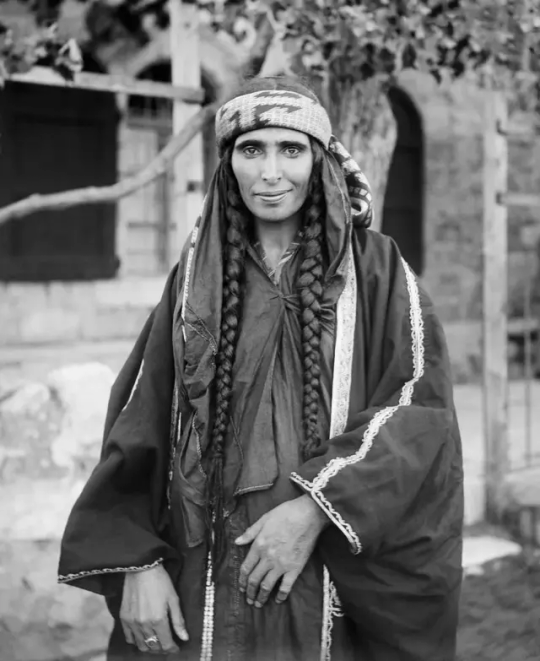
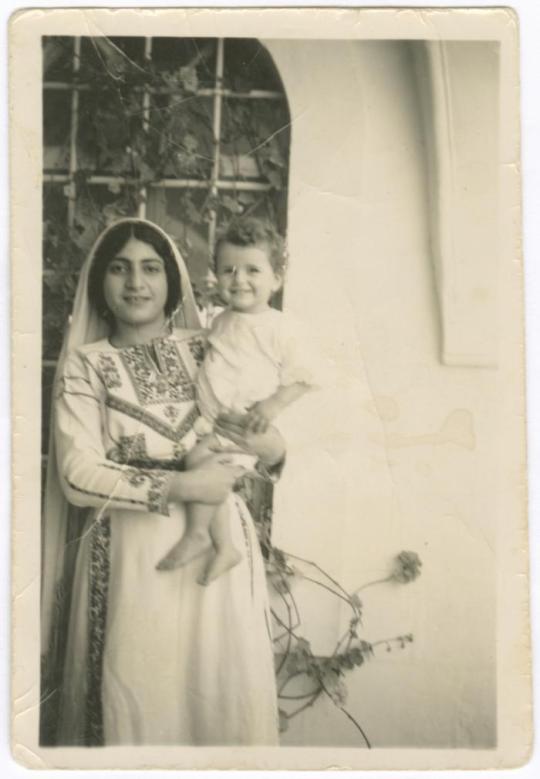


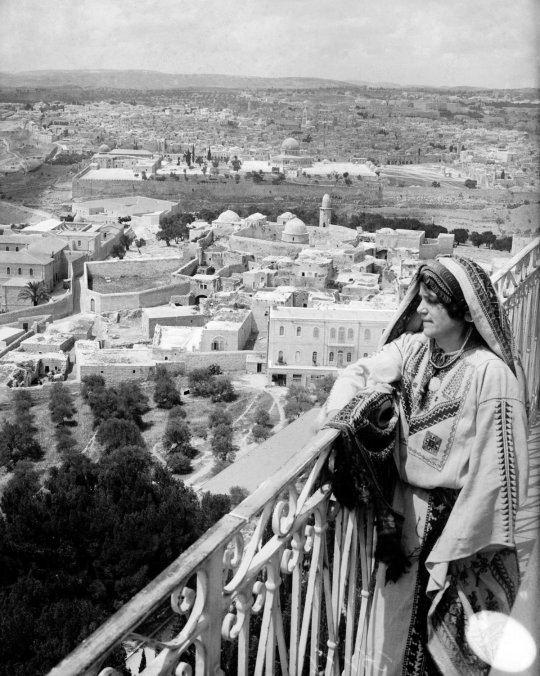


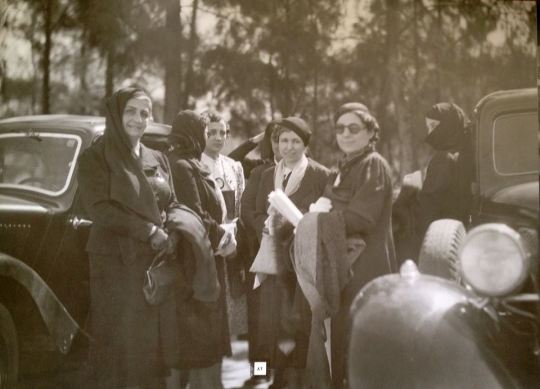
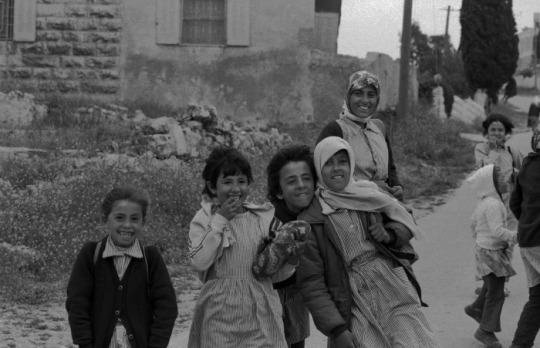
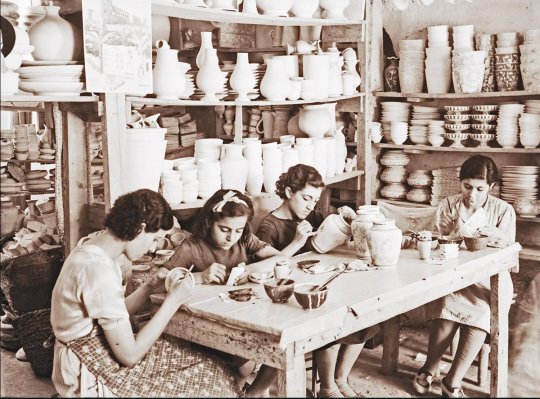
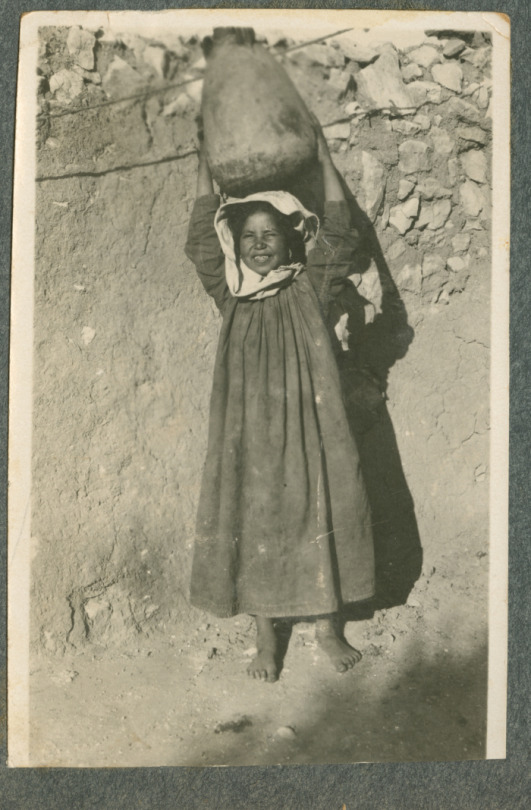

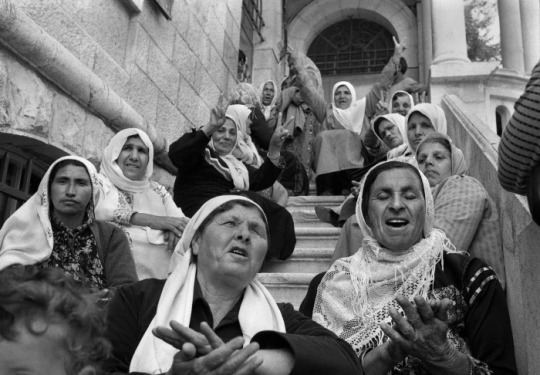
Moments from Palestine across generations and communities
(1) A Bedouin woman smiles in Jerusalem (1898-1914)
(2) Asma Aranki Holding a Child from Her Family at Their House, Birzeit (1948)
(3) Bedouin girls in Jericho (1918)
(4) An extended Palestinian family gathers in front of their house in the village of Beit Sahur, near Bethlehem (1918–35)
(5) From the Mount of Olives, a young woman looks out over eastern Jerusalem (1929)
(6) Ruth Raad, daughter of photographer Khalil Raad, in the traditional costume of Ramallah (1939)
(7) Standing in his neatly ironed shirt and shorts, George Sawabin poses for a studio photo (1942)
(8) Katingo Hanania Deeb, prepares to demonstrate in the 1936-1939 Arab Revolt -- which was a nationalist uprising by Palestinian Arabs against British colonial rule in relation to Palestinian independence and the land acquisition and pushout as a result of the mass Jewish immigration (1936)
(9) Young children walking home from school Beit Deqqo Village, the Occupied Palestinian West Bank, 1987
(10) Four young girls decorating vases in a ceramic workshop in Nablus (1920)
(11) A young Palestinian girl squints and smiles as she holds a jar on her head (1920-1950)
(12) The ancient craft of a Palestinian potter (1918-35)
(13) The mothers of Palestinian detainees' protest in Jerusalem (1987)
Source(s): The British Mandate Jerusalemites (BMJ) Photo Library, Palestinian Museum Digital Archives, The Jerusalem Story + Khalil Raad
Please support, share, cite, and (if financially able) fund these organizations and public storytellers for their rebellious histories and community work!
#decolonization#our world#our history is your history#people#free palestine#palestine#indigenous rights#art of making#and manifesting#history is not neutral#futurepast
4K notes
·
View notes
Text
Immediate Steps to Take if your Loved One is Detained by ICE
The US Immigration and Customs Enforcement (ICE) team can detain any removable or undocumented immigrant after arresting them. ICE detains an individual when they have a reasonable cause for suspicion that the person has violated immigration rules. However, detainees and their families must not lose hope in such a situation. An Immigration Court trial may restore their right to continue living on US soil. US immigration bonds offer an excellent option to bail out ICE detainees so they can get out of detention. If your loved one is detained by ICE, you must follow these tips to navigate this devastating situation.
Responding To A Friend Or Family Member’s ICE Detention: Here’s What You Should Do
Here are the things you should do when you hear about your loved one’s detention:
Locate The Detainee: ICE has detention centers all over the US. You must know where your loved one is detained before taking any steps. To locate them, you need to use the online detainee locator system. You can find your loved one by using their Alien Registration Number and country of birth. This number is listed as the USCIS# on various immigration-related documents. You may find it on the detainee's Green Card, Work Permit (EAD), Immigrant Visa, Immigrant Data Summary, Immigrant Fee Handout, or Notice of Action. If you cannot find the Alien Number, you may try to locate them on the system using their first and last names, date of birth, and country of birth. Our bail bond agents can help you during this process.
Contact an Immigration Bail Bondsman: You can reach out to a reputed immigration bail bond company like Amistad. Their expert agents can help you prepare the necessary documents and initiate the process of paying the bail bond amount. You can consult them about the way forward and discuss payment plans for posting bail. If your loved one is eligible for bail, the ICE officials will set a bail amount. If you cannot afford the bail, our bail bond agent can offer two payment options and post the bail on your behalf.
Prepare Relevant Documents: You should prepare documents to show that your loved one is eligible for bail. The eligibility requirements stipulate that the person should not be a threat to the community and must not be likely to run away. You can collate proofs of community involvement and letters from neighbors and friends to establish their moral character. You can also show evidence of family ties by arranging documents like marriage certificates to show that they are not a flight risk.
Identify a Sponsor: The sponsor takes responsibility for paying the bail and housing the detainee after they come out of custody. You can choose a friend or family member to be the detainee's sponsor when they get bail. The sponsor must be either a permanent resident of the US or a legal citizen of this country. They have to submit a letter stating their relationship with the detainee and their plans for supporting the detainee. The sponsor must ensure that the bailed person attends all Immigration Court proceedings when scheduled.
Hire An Immigration Attorney: An immigration attorney can help your loved one prepare for their trial at the Immigration Court. You should find legal representation for the bailed individual so they can get a favorable verdict and avoid negative repercussions.
If you need more help, contact the immigration bond agents at Amistad for a free consultation! They can help with immigration bonds in Georgia, Louisiana, Texas, and various other places in the US.
Blog Source : https://bailbondsraleighnc.blogspot.com/2023/01/immediate-steps-to-take-if-your-loved.html
0 notes
Text
The 108-page report, which is based on interviews with more than 6,000 people during site visits over a two-year period, says the New Orleans ICE office has a pattern of holding people in detention for longer than its counterparts elsewhere, detailing multiple examples of people held at least three months after they were ordered removed.
Interviewees also reported unsanitary living conditions and meals, citing experiences where the facilities ran out of toilet paper and menstrual products, offered spoiled food at mealtimes, were infested by pests and mold, didn't have enough warm clothing, and had feces- and vomit-covered sleeping areas. Some also cited limited or no access to medical and mental health care.
In many instances, the detainees report being left hungry and laughed at by guards as they navigated unclean spaces and rotten food.
The researchers also describe extensive use of solitary confinement, including one case where a Pakistani immigrant describes being held in solitary for more than 200 days for requesting meals appropriate for his diabetes.
672 notes
·
View notes
Text
With the announcement that the UK Government plan to start detaining people for the Rwanda flights today, here are some resources if you are at risk of detention.
IF YOU OR SOMEONE YOU KNOW HAS BEEN DETAINED OR YOU BELIEVE THEY WILL BE DETAINED SHORTLY:
If you are being made to report Right to Remain have an action plan toolkit for BEFORE you report
If you have received a letter from the Home Office dated after March 1st that mentions Rwanda or Notice of Intent, send a photo of the letter and your full name to Care4Calais via Whatsapp at +44 751 977 3268
If you are detained you can call any of the following for legal advice:
Detention Action 0800 587 2096
Care4Calais 0800 009 6268
Soas Detainee Support 0743 840 7570
BID (Bail for Immigration Detainees) 020 7456 9750 (mon-thurs 10-12)
JCWI (Joint Council for the Welfare of Immigrants) 0800 160 1004 (mon, tues, thurs 10-1)
If you do not have legal representation:
Duncan Lewis are taking on cases for anyone detained for the purposes of removal to Rwanda, contact [email protected] or call 0333 772 0409
Wilson are also taking on cases, contact [email protected] or call 0208 808 7535
IF YOU ARE DETAINED DO NOT SIGN ANYTHING WITHOUT LEGAL ADVICE, AND IF THEY OFFER YOU TO GO TO RWANDA 'VOLUNTARILY' OR FOR MONEY SAY NO.
#rwanda#rwanda scheme#uk#uk politics#immigration#migrants rights#detention#immegration detention#resources#please share#ukpol#current events#deportation
199 notes
·
View notes
Text
Captivity is a constitutive part of Palestinian life under occupation. Prior to Hamas’s attack on October 7th, Israel incarcerated more than 5,200 Palestinians—most of them residents of the West Bank and East Jerusalem—across two dozen prisons and detention centers. Some West Bank residents are incarcerated due to a still-operant military order issued following the 1967 War that effectively criminalized civic activities (e.g. gatherings of more than ten people without a permit, distributing political materials, displaying flags) as “incitement and hostile propaganda actions.” There are currently hundreds of such military orders, which criminalize anything that might be construed as resistance to the occupation. This surfeit of activities made illegal for Palestinians authorizes mass imprisonment: According to a recent estimate by the United Nations, one million Palestinians have at one time been incarcerated by Israel, “including tens of thousands of children.” One in five Palestinians, and two in five Palestinian men, have been arrested at some point in their lives, and, as of 2021, more than 100 Palestinian children faced up to 20 years in prison for throwing stones.
Not all who are arrested face charges. Israel often and increasingly makes use of “administrative detention,” a relic of the British Mandate era, which allows for indefinite incarceration without a charge or trial, ostensibly for the purpose of gathering evidence. It was a hallmark of apartheid South Africa and has been used to repress opposition in Egypt, England, India, the United States, and elsewhere, especially in the context of anti-immigration and “counter-terrorism” programs. “Since March 2002, not a single month has gone by without Israel holding at least 100 Palestinians in administrative detention,” the Israeli human rights organization B’Tselem notes; often the number is much higher. Prior to October 7th, more than 20% of Palestinian prisoners were administrative detainees; 233 of the 300 Palestinians on Israel’s release list negotiated last week were administrative detainees, Al Jazeera noted. According to the Palestinian prisoner organization Addameer, imprisoned Palestinians report being beaten, threatened, strip searched, and denied healthcare and contact with their families. Palestinians currently incarcerated, as well as those freed in recent days, report that conditions have worsened since October 7th. Meanwhile, even as this prisoner release proceeds, Israel continues to ramp up arrests: As of Tuesday, 180 Palestinian prisoners have been released as part of the ceasefire exchange, but during the same period, it arrested Palestinians at nearly the same rate. Today, more than 7,000 Palestinians are incarcerated in Israeli prisons.
Nowhere is Israel’s carceral regime clearer than in Gaza, the 140-square-mile area often described as an “open-air prison.” Gaza’s residents, now an estimated 2.2 million people—80% of whom are refugees or descendents of refugees forced to flee in the mass expulsions surrounding the founding of the State of Israel that Palestinians call the Nakba—have been hemmed in by a land, air, and sea blockade since 2006. As with Palestinians incarcerated in Israeli prisons, who for years have waged hunger strikes, protested, and written about the horrors of incarceration, Gazans have struggled mightily against their confinement. In 2018–19, they held weekly nonviolent protests at the border under the name Great March of Return. Israel responded with brutal violence, killing 260 people and wounding 20,000 others, many of whom were permanently disabled. A week into Israel’s current assault on Gaza, Ahmed Abu Artema, one of the co-founders of the Great March of Return, wrote an impassioned plea in The Nation, calling for the world to “help us tear down the wall, end our imprisonment, and fulfill our dreams of liberation.” On October 24th, an Israeli airstrike severely wounded Artema and killed five members of his family, including his 13-year-old son.
It is precisely in such contexts of radical asymmetry that we find the history of hostage-taking: In the last half-century, under-resourced combatants from Palestine to Brazil to the United States and beyond have used hostages to gain political leverage. Militants, whose own lives are not valued by the powers they face, capture those whose lives they assume are deemed more valuable. This strategy often succeeds in shifting the terms of the conversation—asserting the previously dismissed hostage-takers as political actors whose demands must be negotiated. But the same dynamic that leads militants to take hostages is why the tactic so often fails: The prison state fundamentally devalues life, and ultimately may sacrifice hostages to preserve its rule. Israeli officials have said as much. “We have to be cruel now and not think too much about the hostages,” finance minister Bezalel Smotrich said in a cabinet meeting as Israel launched its war.
133 notes
·
View notes
Text
Atrocities US committed against AFRICA
In early 2017, the US began conducting drone strikes in Somalia against Al Shabab militants. An attack on July 16th killed 8 people.
In 1998, the US bombed the Al Shifa pharmaceutical factory in Sudan, killing one employee and wounding 11. It was the largest pharmaceutical factory in Khartoum, producing medicine both for human and veterinary use. The US had acted on false evidence of a VX nerve agent from a single soil sample, and later used a false witness to cover for the attack. It was the only pharmaceutical factory in Africa not under US control.
In June 1982, with the help of CIA money and arms, Hissene Habre , dubbed Africa’s Pinochet, takes power in Chad. His secret police, use methods of torture including the burning the body of the detainee with incandescent objects, spraying gas into their eyes, ears and nose, forced swallowing of water, and forcing the mouths of detainees around the exhaust pipes of running cars. Habré’s government also periodically engaged in ethnic cleansing against groups such as the Sara, Hadjerai and the Zaghawa, killing and arresting group members en masse when it was perceived that their leaders posed a threat to the regime. Human Rights Watch claimed that Habre was responsible for thousands of killings. In 2001, while living in Senegal, he was almost tried for crimes committed by him in Chad. However, a court there blocked these proceedings. Then human rights people decided to pursue the case in Belgium, because some of Habre’s torture victims lived there. The U.S., in June 2003, told Belgium that it risked losing its status as host to NATO’s headquarters if it allowed such a legal proceeding to happen. So the result was that the law that allowed victims to file complaints in Belgium for atrocities committed abroad was repealed. However, two months later a new law was passed which made special provision for the continuation of the case against Habre. In May 2016 he was found guilty of human-rights abuses, including rape, sexual slavery and ordering the killing of 40,000 people, and sentenced to life in prison.
In the 1980s, Reagan maintains a close relationship with the Apartheid South african government, called constructive engagement, while secretly funding it in the hopes of creating a bulwark of anti-communism and preventing a marxist party from taking power, as happened in angola. Later on, in the wars against Apartheid in South Africa and Angola, in which cuban and anti-apartheid forces fought the white south african government, the US supplied south africa with nuclear weapons via Israel.
In 1975, Henry Kissinger launches a CIA-backed war in Angola, backing the brutal anti-communist leader of UNITAS, Jonas Savimbi, against Agostinho Neto and his Marxist-Leninst MPLA party, creating a civil war lasting for 30 years. The CIA financed a covert invasion via neighboring Zaire and a drive on the Angolan capital by the U.S. ally, South Africa. Congress continues to fund UNITAS, and their south-african apartheid allies until the late 1980s. By the end of the war, more than 500,000 people had died and over one million had been internally displaced.
In 1966, a CIA-backed military coup overthrows he widely popular Pan-Africanist and Marxist leader Kwame Nkrumah in Ghana, inviting the International Monetary Fund and World Bank to take a lead role in managing the economy. With this reversal, accentuated by the expulsion of immigrants and a new willingness to negotiate with apartheid South Africa, Ghana lost a good deal of its stature in the eyes of African nationalists.
In 1965, a CIA-backed military coup installs Mobutu Sese Seko, described as the “archetypal African dictator” in Congo. The hated and repressive Mobutu exploits his desperately poor country for billions.
In 1962, a tip from a CIA spy in South Africa lead to the imprisonment of Nelson Mandela, due to his pro-USSR leanings. This began his 27-year-long imprisonment.
In 1961, the CIA assists in the assassination of the democratically elected congolese leader Patrice Lumumba, throwing the country into years of turmoil. Before his assassination the CIA sent one of its scientists, Dr. Sidney Gottlieb, to the Congo carrying “lethal biological material” intended for use in Lumumba’s assassination. This virus would have been able to produce a fatal disease indigenous to the Congo area of Africa and was transported in a diplomatic pouch.
In 1801, and again in 1815, the US aided Sweden in subjugating a series of coastal towns in North Africa, in the Barbary Wars. The stated reason was to crack down on pirates, but the wars destroyed the navies of Algeria, Tunisia, and Morocco, and secured European and US shipping routes for goods and slaves in North Africa. US Representatives stated: “When we can appear in the Ports of the various Powers, or on the Coast, of Barbary, with Ships of such force as to convince those nations that We are able to protect our trade, and to compel them if necessary to keep faith with Us, then, and not before, We may probably secure a large share of the Meditn trade, which would largely and speedily compensate the U. S. for the Cost of a maritime force amply sufficient to keep all those Pirates in Awe, and also make it their interest to keep faith.” Thomas Jefferson echoed and carried out the war, saying that war was essential to securing markets along the Barbary Coast.
#late stage capitalism#capitalism#socialism#anarchy#communism#twitter post#rip twitter#leftism#anti capitalism#economics#classism#current events#inequality#liberal#liberal hypocrisy#liberal feminism#tweet#liberalism#woke liberal madness#conservative#republican#democrat#conservatism#africa#unesco#migration#ethiopia#south africa
194 notes
·
View notes
Text
'I Won't Stop Until Israel Admits Its Ties With the Pinochet Regime'
Lily Traubman, who immigrated to Israel in the 1970s, hopes the documents she is trying to get from the Defense Ministry and the Foreign Ministry may even contain information on her father's killers.
A year ago there were headlines when four women filed a suit for sexual abuse they suffered in prison during the Pinochet period. They demanded that the abuse be recognized as a political crime and that their torturers be brought to trial. Were such attacks something that was directed from above?
Of course. Have you heard of “La Venda Sexy”? It was a detention center where people were tortured. The name actually means “Sexy Blindfold,” because the detainees’ eyes were covered the whole time and they were subjected to sexual abuse.
All the detainees were blindfolded the whole time?
Yes. They were arrested, blindfolded and put into a room, together, with their eyes covered. Then they were tortured. Most of the female detainees were raped and underwent sexual abuse. A girlfriend of mine was held there but was not raped. She told me she’d felt fortunate, but then came New Year’s and she was raped. They’d kept her for the holiday.
Venda Sexy was truly awful. They had dogs that were trained to rape women, and they would force spouses and family members to watch the rape. More and more testimonies about these abuses come out all the time.
And throughout this whole period, Israel, under prime ministers Yitzhak Rabin, Menachem Begin and Shimon Peres, maintained excellent relations with Chile. The two countries supported each other in the United Nations and signed bilateral agreements. Army Chief of Staff Mordechai Gur visited Chile in 1978, as did Deputy Prime Minister David Levy in 1982. Both met with Pinochet.
Pinochet was even invited to the synagogue in Santiago on Yom Kippur. Other presidents were not invited.
The documents declassified by the Americans also contain references to arms deals with Israel. Secretary of State George Shultz noted in a 1984 document that Britain, France, Israel and Germany were Chile’s arms suppliers.
All the weapons of the Chilean police and army were Israeli. In Chile I went around with a photograph of my brother in uniform. At checkpoints and in searches I would take out the picture and tell them that this was my brother, who was an officer in the IDF – even though he was a regular soldier – and that did the trick. The Chilean army greatly admired the Israeli army. When Pinochet wanted to visit Israel, he threatened that if he were not received here he would cancel a large arms deal. No dictator in the world, however bad he may be, can exist without international support. The dictatorship in Chile lasted as long as it did because there were countries that supported it, and Israel was one of them.
Israel describes itself as “the state of the Jewish people,” but there are about 20 missing Jews in Chile who were murdered during that period, while Israeli governments and the military maintained close ties with Chile, accorded it legitimization in international forums and provided aid and training to its military and intelligence units.
156 notes
·
View notes
Note
well, why not exactly like south africa? why not like any other arab country where muslims and christians and atheists and hindus live side-by-side just fine? why not like the diverse western nations that finance your state's existence? what exactly about palestinians is so Inherently Evil And Irredeemable (bc that is honestly how you sound) that they would not have the humanity and morality to treat people like people?
it's always the same fear of the day after. white south africans are alive. white american colonisers are fucking thriving. same in australia, in new zealand. immigrants to arab countries lead entire lives there. why not like any of them?
What an exhausting, insulting question... that truly has nothing to do with anything I said. I was speaking about Hamas and leftists who support their aims to dismantle Israel, not the Palestinian people.
I have never said that it’s impossible that Muslims, Christians, Jews, (and Samaritans, Druze, etc.) will live side-by-side. They already do, in Israel. There is discrimination, but they do indeed live side-by-side. What I said was that it will not happen under Hamas rule. Which is an objective fact. The Gaza strip, by the way, is currently 98% Muslim.
I also never said that Palestinians are “inherently evil and irredeemable,” nor did I imply it. You lie in order to paint me, as an Israeli, as hateful. I am not. I spoke only of Hamas. Your conflation of a militant terrorist group with civilians is unfortunate. Hamas has proven time and time again that they do not have the humanity to treat people like people. I said nothing of the Palestinian people.
While I owe you nothing, I'll have you know that I am absolutely in favor of steps towards a peaceful solution and mutual recognition of both nations. I think it is outrageous that there are Palestinian detainees held without charge. I find the number of deaths in Gaza an unacceptable collective punishment. I am supportive of cultural and economic efforts towards reconciliation (e.g., bilingual Arab-Jewish schools and summer camps, joint activism efforts, organizations that promote dialogue and cross-cultural events, shared efforts to help victims of violence, cultural exchange and language learning initiatives). I think the current government is a disaster. I want to see a world where Jews, Christians, and Muslims—and Samaritans, Druze, and Baháʼís—live in peace together in that land. The fact that you saw me saying that Hamas would enact genocide if given the chance (which is true) and interpreted that as me saying Palestinians are “inherently evil” (which I did not say) is truly sad.
The reality is Hamas is not a resistance group. It is an Islamic ultranationalist militaristic dictatorship that has kept its citizens as prisoners by stealing international aid and running military operations to commit war crimes from under schools and hospitals. It is a terrorist group that rapes, murders, and tortures civilians, including children and infants. Peace in the region will not be possible without a demilitarized Gaza. Hamas rule is incompatible with peace. If you support Hamas, you support the violent expulsion or genocide of Israeli Jews from our homeland. You can (and should) be in support of Palestinian self-determination. This belief is also incompatible with support for Hamas. Israeli war crimes do not absolve Hamas's war crimes.
Another thing I find interesting is that you refer to a dismantled Israel as “another Arab country,” and in the same breath claim that Jews would continue to live there. I wonder, was it a coincidence that you failed to list Jews in your list of religions living side-by-side, or are you aware that there are very, very few Jews living in Arab countries today? In case you are unaware, the absence of Jews from the Arabian peninsula, the Mesopotamian region, and North Africa is a result of diasporic Jewish minorities fleeing, being expelled, and/or being ethnically cleansed. Prior to that, they lived with second class status (dhimmis) under Islamic rule. As an Israeli Jew, I cannot set foot in many Arab countries today. Is that your version of coexistence?
And let us be clear: The remaining ethnic minority groups do not live in peace in the Muslim-majority countries of the region. The examples are endless. The genocide of the Yazidis by the Islamic State. The Houthi persecution of Yemenite Jews and Baháʼís. The displaced Christians from the Syrian civil war. The Middle East is rife with examples of radicalized religious extremists being entirely incompatible with coexistence with minority groups.
Yet, in your list of co-existing religions, you picked Hinduism: a minority religion that, while practiced in some Middle Eastern countries, is not indigenous to the region. Perhaps you did this in ignorance. Perhaps it was an attempt to support your point that some immigrants and migrants can indeed lead reasonable lives in Arab countries (e.g., Indian expats in the Emirates or Saudi Arabia), as ethnic minorities with a homeland to return to. Needless to say, it's an irrelevant and feeble attempt to claim that religions currently coexist well in the Muslim-majority countries. As a whole, they do not.
Let's talk about your list of colonizers next. White South Africans being alive has nothing to do with Israel. White people thriving in the USA, Australia, and New Zealand have nothing to do with Israel. Those examples are particularly bizarre anyway, as, excepting South Africa, you’ve picked countries where the colony essentially remained in place and became the ethnic majority. But none of these colonies have anything to do with Israel, because Israel is not a colony.
Jews are indigenous to Israel. We are one of a small number of indigenous Levantine ethnic groups who call that land home. The word colony requires a context we do not have–a colony for what country? What existing country is expanding territory? We are a 4000 year old nation, many of us displaced by the Romans, and who, after 2000 years of oppression and genocide both in the diaspora and in our homeland, won our independence from the occupying force in power at the time: the British. We have nothing to do with European colonizers. You cannot colonize your own homeland.
Again, that does not mean I support the Israeli government or the IDF's actions. I fully believe Palestinians also deserve self-determination in our shared land. Our status does not change the Palestinian story. It does not undo their suffering. The situation in Gaza is untenable and an outrage. Our status does not change the inhumane conditions that Israel, along with other countries (like Egypt) have placed on the population of Gaza.
But Jews being indigenous to the region matters—because the context to understand Israel is not one of colonizer-colonized. Ours is an ethnic conflict in the context independence after a long history of many colonial powers (British, Ottoman, etc.), a wider political context of Arabization and oppression of ethnic/religious minority groups in the entire Middle East, as well as a global context of hatred of Jews and Arabs, and of Western meddling.
It also matters because it highlights the fact that Palestinians are our cousins—both because many Palestinians are likely decedents of Jews, Samaritans, etc. who were Arabized and forcibly converted Islam—but also because the Arabs are our cousins too. It is important to remember that this is an ethnic conflict, and not a situation in which one group can "go home." We have to find a way to coexist. Hamas is not that way.
Is “leading a life,” as you say, enough? Well, we wouldn't be able to, under Hamas. They have made that clear. But even if a Hamas-led state made room for dhimmi-status Jewish Israelis, then no, it would not be enough. (Remember, it is not even enough for many Palestinians who hold Israeli citizenship to live under our state with full rights.) Self-determination is important. Maintenance of language and culture is important. Statehood matters, for both Palestinians and Israelis. I do not believe we are ready for a fully unified state. Perhaps we never will be. But whatever the solution, it is imperative that both people have self-determination in their homeland.
And be it a unified democratic binational state, a single federal government with autonomous cantons/states that govern themselves, a "two states, one homeland" two state confederation, a fully-realized two state solution, or any other solution: the violent—and yes, evil—Hamas regime can play no part.
#israel palestine conflict#israel#palestine#westoid leftoids at it again#leftist antisemitism#jumblr
119 notes
·
View notes
Text
Number of ICE Detainees Increases for First Time Since June
0 notes
Text
The state intervenes in children’s use of the city, criminalising children’s uses of the streets [...]. Much of this age-segregation emerged in the so-called Progressive Era (1890-1918) in northern cities of the United States, particularly Chicago. Informed by turn-of-the-century science [...], [t]hese child-savers sought to transform delinquent urban children into upright citizens. In doing so, reformers changed the shape of America’s cities. [...] Only a handful of dedicated playgrounds existed in urban America in the 1890s. [...] Contrasting images of working-class, immigrant youth left unsupervised on the streets with children of their own class, who led increasingly sheltered lives, middle-class urbanites feared for the future of the country. The burgeoning reform class, led by Chicagoans such as Jane Addams, feared so-called “swarms” of children on the streets [...].
---
A new theory of child-development known as recapitulation theory had recently emerged. Proponents of this theory, such as G. Stanley Hall, argued that children passed through (or recapitulated) all the stages of the evolution of the race before they achieved adulthood. [...] Advocates [...] idealised almost all of white boys’ misbehaviour as recapitulation of the race’s past [...]. Although recapitulation theory had room for the sons of European immigrants, [...] children of colour remained outside the narrative of idealised misbehaviour. [...] [W]hite Americans [...] sought to repress the misbehaviour or so-called childhood savagery of children of colour rather than encourage it. Thus, just as white children were encouraged to embrace their inner savage and hold mock powwows and “to play Indian”, Progressive reformers confined Native American children to “civilizing” boarding schools [...].
Growing concerns over masculinity at the turn of the twentieth century limited reforms that could be seen as “molly-coddling”. To completely crush the misbehaving instinct, many middle-class Americans believed, would be just as dangerous [...]. Drawing on recapitulation theory, reformers believed the key to anti-delinquency among [...] European [...] children was providing these children with supervised, orderly places where the misbehaving instinct could safely play out. Central to reformers’ attempts to save but not tame [...] children meant the development of the world’s first municipal playground system in Chicago [...]. By 1915, the city of Chicago ran sixty-six recreation centres [...]. President Teddy Roosevelt heralded it as “one of the most notable civic achievements of any American city.” From Chicago, the idea spread around the country. By 1921, almost 200 cities employed a total of over eleven thousand men and women as year-round playground workers. [...]
---
But the state, too, struggled to control urban childhood. [..] [T]ruant officers [...] struggled with huge caseloads in the early twentieth century. [...] On the streets, escapees evaded police, probation and truant officers [...]. A study of reform schools in and near Chicago in the early twentieth century found two-fifths of detainees left in what was euphemistically called ‘informal departure’ [...]. Escape caused such an issue for reformatories that it was considered among the most serious offences and, as such, carried the heaviest punishments including beatings, being hung by the wrists, being shackled, wearing heavy iron studded shoes, being placed in a tub of ice water, and being caged.
Even as Progressive ideals ostensibly moved prisons and other reform institutions further from the punishment of the body to the treatment of the individual’s soul, in practice, reformatory officials often resorted to physical punishments for the treatment of runaways. [...] [T]he new juvenile institutions of the early twentieth-century differed so wildly in practice from their conception in theory. [...]
---
By the 1930s, however, the concept of the dangerous but ultimately salvageable swarm which had shaped Progressive Era responses to the problems of children and the city was gradually replaced by the far more pessimistic idea of individual deviant personalities. Faith in the ability to transform children through transforming the city collapsed. [...] Juvenile Courts also faced increasing pessimism. In 1936, leading child-saver Grace Abbott asked rhetorically whether the Juvenile Court of Chicago had proved a success or a failure and concluded pessimistically [...].
Delinquency experts increasingly turned to psychiatry to explain and treat criminal behaviour; the psychiatrist supplanted the playground as the key to anti-delinquency.
---
As reformers advocated individualised treatment of delinquent personalities, on the streets, changing priorities of policing increasingly and aggressively targeted children of colour. In addition, suburbanisation was changing the demographics of the inner city. Increasingly, white families were choosing to move out to the suburbs [...]. As inner-city youth became more and more synonymous with minority youth, the urban child seemed increasingly outside the realm of “saving” and middle-class white Americans responded to black youth’s corner culture with intense policing and urban flight, not playgrounds and child-saving. The pessimistic view [...] laid the foundation for the increasingly racialised and violent attempts to control poor urban children in the later twentieth century. [...]
---
Most importantly, Progressive reformers criminalised and delegitimised much of children’s traditional use of the streets, ensuring that age became a crucial component of urban discipline. [...] When encounters with real children transformed institutions and regulations in unexpected ways, the result was increasingly coercive methods and policing.
---
All text above by: Oenone Kubie. “Child’s Play: How Progressive Era Science Shaped America’s Playgrounds.” Oxford Urbanists. 15 September 2019. [Bold emphasis and some paragraph breaks/contractions added by me.]
#abolition#ecology#colonial#imperial#carceral geographic#geographic imaginaries#ecologies#multispecies#debt and debt colonies#black methodologies
312 notes
·
View notes
Text
Nova Scotia has become the first province to stop holding immigration detainees in its jails on behalf of the federal government. Canada Border Services Agency spokeswoman Rebecca Purdy says the province ended the practice Aug. 8. Other provinces, including British Columbia and Alberta, have said they too would stop holding immigration detainees. However, both of those provinces have agreed to temporarily continue housing high-risk detainees in jails, but are not accepting new inmates.
Continue Reading.
Tagging: @politicsofcanada
112 notes
·
View notes
Text









New Releases - Week of August 27, 2024
We've found eight different new releases to shout about this week. Are any of them on your TBR?
Bridge Across the Sky by Freeman Ng Atheneum Books for Young Readers
A raw and honest historical novel in verse about a Chinese teen who immigrates to the United States with his family and endures mistreatment at the Angel Island Immigration Station while trying to navigate his own course in a new world.
Tai Go and his family have crossed an ocean wider than a thousand rivers, joining countless other Chinese immigrants in search of a better life in the United States. Instead, they’re met with hostility and racism. Empowered by the Chinese Exclusion Act, the government detains the immigrants on Angel Island in the San Francisco Bay while evaluating their claims.
Held there indefinitely, Tai Go experiences the prison-like conditions, humiliating medical exams, and interrogations designed to trick detainees into failure. Yet amid the anger and sorrow, Tai Go also finds hope—in the poems carved into the walls of the barracks by others who have been detained there, in the actions of a group of fellow detainees who are ready to fight for their rights, in the friends he makes, and in a perceived enemy whose otherness he must come to terms with.
Unhappy at first with his father’s decision to come to the United States, Tai Go must overcome the racism he discovers in both others and himself and forge his own version of the American Dream.
The Sticky Note Manifesto of Aisha Agarwal by Ambika Vohra Quill Tree Books, Harper Collins
“How have you gotten out of your comfort zone?”
That’s the Stanford admissions prompt that valedictorian shoo-in Aisha Agarwal can’t answer. Her life’s been homework and junk food. So, when her crush, Brian, asks her to winter formal, Aisha thinks her fate is changing . . .
. . . until Brian stands her up.
As if on cue, a banged-up Volkswagen arrives outside the dance; the driver profusely apologizing for being late to pick her up. Does Aisha know him or what he’s talking about? No. Does the Stanford essay convince her to take him up on the ride? Absolutely.
To Aisha’s relief, seventeen-year-old Quentin Santos isn’t a kidnapper, but he is failing math. They strike a deal: if Aisha helps Quentin pass math, he’ll help push her out of her comfort zone, using a series of sticky note to-do’s—dares—that will not only give Aisha content for her essay, but will turn her into the confident person she’s always wanted to be.
From New Year’s Eve kisses to high school parties, Aisha’s sticky note manifesto is taking off. But when she falls for the wrong guy, hurts her best friend, and still can’t finish her essay, victory feels far from reach.
Is winning worth it if you end up losing yourself in the process?
Indiginerds edited by Alina Pete Iron Circus Comics
First Nations culture is living, vibrant, and evolving…
…and generations of Indigenous kids have grown up with pop culture creeping inexorably into our lives. From gaming to social media, pirate radio to garage bands, Star Trek to D&D, and missed connections at the pow wow, Indigenous culture is so much more than how it’s usually portrayed. These comics are here to celebrate those stories!
Featuring an all-Indigenous creative team, INDIGINERDS is an exhilarating anthology collecting 11 stories about Indigenous people balancing traditional ways of knowing with modern pop culture.
Bvlbancha Forever, by Ida Aronson and Tate Allen
Walk With The Earth Mother, by Maija Plamondon and Milo Applejohn
Roll Your Own Way, by Jordanna George
Digital Eden, by Raven John and Asia Wiseley
Amplification/Adaptation, by Em Matson and Nipinet Landsem
Welei (I Am Fine), by Bianca “binkz17” and Rhael McGregor
Saving Throws, by James Willier and Sam “Mushki” Medlock
Dorvan V, by Alina Pete
Uncured Horror, by Gillian Joseph and Wren Rios
Airwaves Pirates, by Autumn Star and PJ Underwood
Missed Pow Wow Connection, by Kameron White
Twin Flames by Olivia Abtahi Lee & Low Books
When djinn start to show up in twins Leila and Bianca’s small Virginia hometown, the only way they and their families will survive will be if the twins can get past their differences and start to act like sisters again.
Twins Bianca and Leila could not be more different from each other. Being both Argentinian and Iranian in a small town has always been hard, but with Leila shunning her heritage and Bianca embracing it, the two walk very different paths. They run in different circles of friends, and barely talk anymore. Leila’s a homebody who loves to craft and plans on marrying her high school sweetheart. Bianca’s more anti-establishment and plans to get out of Dodge as soon as humanly possible.
But on their eighteenth birthday, the neighbor’s barn is burned down–and it doesn’t seem to have been caused by anything normal like an electrical or fuel source. When Leila encounters a mysterious monster arising from the fire, suddenly she gains strange powers–and can no longer touch iron or even eat foods with high iron content.
What are these creatures and where are they coming from? What do they want with Leila–or other people in town, for that matter? Can the twins learn to rely on each other–and their cultures–to banish them? It’ll take a sisterly reconciliation for the girls to find out and to save their hometown in this New Visions Award-winning fantasy adventure.
Everything We Never Had by Randy Ribay Kokila
From the author of the National Book Award finalist Patron Saints of Nothing comes an emotionally charged, moving novel about four generations of Filipino American boys grappling with identity, masculinity, and their fraught father-son relationships.
Watsonville, 1930. Francisco Maghabol barely ekes out a living in the fields of California. As he spends what little money he earns at dance halls and faces increasing violence from white men in town, Francisco wonders if he should’ve never left the Philippines.
Stockton, 1965. Between school days full of prejudice from white students and teachers and night shifts working at his aunt’s restaurant, Emil refuses to follow in the footsteps of his labor organizer father, Francisco. He’s going to make it in this country no matter what or who he has to leave behind.
Denver, 1983. Chris is determined to prove that his overbearing father, Emil, can’t control him. However, when a missed assignment on “ancestral history” sends Chris off the football team and into the library, he discovers a desire to know more about Filipino history―even if his father dismisses his interest as unamerican and unimportant.
Philadelphia, 2020. Enzo struggles to keep his anxiety in check as a global pandemic breaks out and his abrasive grandfather moves in. While tensions are high between his dad and his lolo, Enzo’s daily walks with Lolo Emil have him wondering if maybe he can help bridge their decades-long rift.
Told in multiple perspectives, Everything We Never Had unfolds like a beautifully crafted nesting doll, where each Maghabol boy forges his own path amid heavy family and societal expectations, passing down his flaws, values, and virtues to the next generation, until it’s up to Enzo to see how he can braid all these strands and men together.
Our Shouts Echo by Jade Adia Disney-Hyperion
Survival Tip #1: The world is going to shit. Whatever you do, trust no one.
Sixteen-year old Niarah Holloway’s only goal in life is to get through it unnoticed. That, and to spend her first summer in LA building a doomsday bunker in her backyard. Because if the past few years have taught Niarah anything, it’s that the ocean levels are rising, minimum wage is a scam, and the people who are supposed to protect you will hurt you. Now the only thing that helps Niarah stay afloat amidst the constant waves of anxiety and dread that threaten to drag her under is her new mantra: Be prepared.
But Niarah wasn’t prepared for Mac Torres. Not for his disarmingly cute face, or for his surfer lifestyle, or for the way his smile resuscitates her heart. Mac is a bomb that blows Niarah’s world to pieces, but instead of disaster, he fills it with sunset bonfires, breakfast burritos, and new friends.
For years, Niarah’s life has revolved around ignoring the demons of her past, avoiding the problems of her present, and preparing for the catastrophes of the future. Now Mac—with his sunshine laugh and infectious optimism— is determined to show her another way to be. But in a world where the worst feels inevitable, can one summer be enough to light the way to a hopeful future? Can one summer be enough to fall in love?
With Love, Echo Park by Laura Taylor Namey Atheneum
Seventeen-year-old Clary is set to inherit her family’s florist shop, La Rosa Blanca—one of the last remnants of the Cuban business district that once thrived in Los Angeles’s Echo Park neighborhood. Clary knows Echo Park is where she’ll leave a legacy, and nothing is more important to her than keeping the area’s unique history alive.
Besides Clary’s florist shop, there’s only one other business left founded by Cuban immigrants fleeing Castro’s regime in the sixties and seventies. And Emilio, who’s supposed to take over Avalos Bicycle Works one day, is more flight risk than dependable successor. While others might find Emilio appealing, Clary can see him itching to leave now that he’s graduated, and she’ll never be charmed by a guy who doesn’t care if one more Echo Park business fades away.
But then Clary is caught off guard when an unexpected visitor delivers a shocking message from someone she thought she’d left behind. Meanwhile, Emilio realizes leaving home won’t be so easy—and Clary, who has always been next door, is who he confides in. As the summer days unfold, they find there’s something stronger than local history tying them together.
Libertad by Bessie Flores Zaldivar Dial Books
A queer YA coming-of-age set during the rigged Honduran presidential election, about a young poet discovering the courage it takes to speak her truth about the people and country she loves.
As the contentious 2017 presidential election looms and protests rage across every corner of the city, life in Tegucigalpa, Honduras churns louder and faster. For her part, high school senior Libertad (Libi) Morazán takes heart in writing political poetry for her anonymous Instagram account and a budding romance someone new. But things come to a head when Mami sees texts on her phone mentioning a kiss with a girl and Libi discovers her beloved older brother, Maynor, playing a major role in the protests. As Libertad faces the political and social corruption around her, stifling homophobia at home and school, and ramped up threats to her poetry online, she begins dreaming of a future in which she doesn’t have to hide who she is or worry about someone she loves losing their life just for speaking up. Then the ultimate tragedy strikes, and leaving her family and friends—plus the only home she’s ever known—might be her only option.
14 notes
·
View notes
Text
Noah Berlatsky at Public Notice:
Donald Trump has repeatedly promised that if he returns to the White House, he will deport every undocumented person in the US. Most experts say that would be 11 million people, but Trump has insisted that the number is closed to 18 million or even 30 million. Trump’s provided few details about how he would go about accomplishing such a massive forced relocation program, though he’s suggested he would deputize local police, call in the National Guard, and perhaps use the military. He’s also said, with some relish, that “getting them out will be a bloody story.” This past weekend, Trump turned his violent and dehumanizing rhetoric up to 11, proclaiming during an event in Prairie du Chien, Wisconsin, that migrants “will walk into your kitchen, they’ll cut your throat.”
“These people are animals,” Trump said, vowing that "I will liberate Wisconsin from this mass migrant invasion of murderers, rapists, hoodlums, drug dealers, thugs, and vicious gang members. We're going to liberate our country." This Trumpian dystopia bears no resemblance to reality. Trump went as far as to claim that “hundreds of little cities and little towns" in the Midwest are being "occupied" by migrants with "MK-47s." As untethered from reality as he is, Trump is deadly serious about attempting deportation on an unprecedented scale. Even making an attempt to round up that many people would lead to horrific suffering and the weaponizing of state terror against immigrants, Latinos, Black people, and Trump’s partisan enemies. In short, Trump is calling for a massive military operation that seems designed to lead to economic misery, concentration camps, and mass death.
Mass deportation would be massively expensive
Experts are skeptical that Trump could enact his terrifying deportation agenda in part because to do so would require vast amounts of money. The funds would have to come from Congress, and even far right legislators are likely to balk at the cost. In 2023, ICE deported 142,580 people with a budget of $420 million. Trump wants to deport at minimum 10 million individuals; proportionally, that would cost about $30 billion.
There would be huge additional costs as well. ICE currently spends some $2.4 billion a year on 41,500 detainee beds. Trump is calling for more than 10 times as much deportation; the cost for warehousing immigrants could also be tens of billions of dollars. Even that’s only scratching the surface of the cost. Immigrants contribute to the economy by paying taxes, performing needed jobs, and providing income for households that include US citizens. Undocumented people paid $96.7 billion in taxes in 2022; that’s all money that would be lost if Trump got his wish. In addition, the Center for Migration studies estimates that if a third of US citizen children of undocumented immigrants remain in the US after their parents are deported, the state would end up spending $118 billion to care for them. GDP could contract 1.4 percent in the first year. Losses could total $4.7 trillion over a decade.
As the Washington Monthly argues, deporting 11 million immigrants would cause a national labor contraction and recession; there could be 968,000 job losses for American citizens. National wage and salary income could fall by $317.2 billion. Total deportation costs could be $265 billion. In short, it’s impossible to fully anticipate or predict the cost of such a huge, wasteful, ill-considered program. But Trump’s deportation nightmare is likely to make the country poorer by trillions of dollars. Recession, contraction, and economic misery will afflict the US for years, and possibly decades.
Mass deportation will lead to mass human rights abuses
Analysts have struggled to quantify and describe the human rights implications of Trump’s deportation strategy. A militarized force going door to door throughout the country with sweeping powers to arrest anyone they deem suspicious is obviously going to lead to monstrous abuses.
Trump has also said that he would be open to creating mass concentration camps at the border to warehouse undocumented people. He’s claimed these camps would be temporary since he plans to deport people quickly — but it’s easy to imagine hundreds of thousands of people housed in “temporary” facilities without adequate food or water, subject to rampant disease and violence from guards. There are at least some historical blueprints that can give us a sense of how dangerous and vicious a mass deportation program could be. Trump has repeatedly touted the Eisenhower-era Operation Wetback, named for a racist slur, as an inspiration for his policy. The operation was conducted by a task force of around 800 agents, who set up roadblocks and raided homes and workplaces in 1954 and 1955. Eisenhower’s deportation program ejected between 300,000 and 1.3 million people in 1954-1955. The Mexican government helped, in hopes that returned migrants would help with the country’s labor shortage.
Donald Trump’s mass deportation plan to deport all undocumented immigrants is a catastrophic disaster for our economy and for civil liberties.
15 notes
·
View notes
Text
9 notes
·
View notes